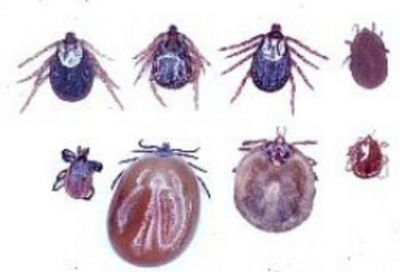Tick Identifier
There are 4 genus of hard bodied ticks and eight species of ticks I will try to help you Identify:
1. Ixodes ( Blacklegged deer tick; Ixodes scapilaris, Western Blacklegged ticks; Ixodes pacificus)
2. Dermacentors 34 species known;
(American Dog tick; Dermacentor variabilis, Rocky Mountain wood tick; Dermacentor andersoni, Pacific Coast Tick; Dermacentor occidentalis)
3. Amblyommas Gulf Coast Tick; Amblyomma maculatum, Lone Star Tick: Amblyommas americanum
4. Rhipicephalus Brown Dog Tick; Rhipicephalus sanguineus
In a recently released article, names 8 species known to carry the borrelia bacteria.
Blacklegged ticks
or Deer ticks
(Ixodes scapularis)
Blacklegged ticks (a.k.a Deer ticks) take 2 years to complete their life cycle and are found predominately in deciduous forest. Their distribution relies greatly on the distribution of its reproductive host, white-tailed deer. Both nymph and adult stages transmit diseases such as Lyme disease, Babesiosis, and Anaplasmosis.












































American Dog Ticks
Dermacentor variabilis
American Dog ticks are found predominantly in areas with little or no tree cover, such as grassy fields and scrubland, as well as along walkways and trails. They feed on a variety of hosts, ranging in size from mice to deer, and nymphs and adults can transmit diseases such as Rocky Mountain Spotted Fever and Tularemia. American dog ticks can survive for up to 2 years at any given stage if no host is found. Females can be identified by their large off-white scutum against a dark brown body.
Rocky Mountain
Wood ticks
(Dermacentor andersoni)
Rocky Mountain Wood ticks are found predominantly in shrublands, lightly wooded areas, open grasslands, and along trails, mainly at lower elevations. All life stages of this tick can transmit Colorado tick fever virus (CTFV) to humans, and Rocky Mountain spotted fever (RMSF) rickettsia (Rickettsia rickettsii) to humans, cats, and dogs. Rocky Mountain wood tick saliva contains a neurotoxin that can occasionally cause tick paralysis in humans and pets; usually a bite from an adult female induces an ascending paralysis that dissipates within 24-72 hrs after tick removal.


































Brown Dog Tick
(Rhipicephalus sanguineus )
Brown Dog Ticks have a world-wide distribution, and can be found throughout the United States, although they are encountered more frequently in the southern tier of states. All life stages of this tick can transmit Rocky Mountain Spotted Fever rickettsia (Rickettsia rickettsia) to dogs, and rarely to humans. Both nymphal and adult stages can transmit the agents of canine ehrlichiosis (Ehrlichia canis) and canine babesiosis (Babesia canis vogeliand Babesia gibsoni-like) to dogs.
Lone Star ticks
(Amblyomma americanum )
Lone Star ticks are found mostly in woodlands with dense undergrowth and around animal resting areas. The larvae do not carry disease, but the nymphal and adult stages can transmit the pathogens causing Monocytic Ehrlichiosis, Rocky Mountain Spotted Fever and 'Stari' borreliosis. Lone Star ticks are notorious pests, and all stages are aggressive human biters.






























Pacific Coast Tick
(Dermacentor occidentalis)
Adults of the Pacific Coast Tick are brown with off-white mottling acrossthe male’s entire back and a portion of the female’s. The latin word “occidentalis” means western, an appropriate name for a tick which is only found in Oregon, California, northern Baja California, and Mexico. Adults have been collected in California year-round but are most abundant in the spring. Among adult hosts are deer, cattle, horses, and man. Sub-adults are most abundant in spring and summer and feed primarily on rodents, especially squirrels. In Lake County, adults of this species are commonly collected in the same habitats as the Western Black-legged Tick.
The Pacific Coast Tick has been found naturally infected with a virus and multiple bacteria that cause disease in humans: among these is the bacterium Rickettsia 364D. The first human infection with this pathogen was reported in Lake County in 2008 (Shapiro et al. 2010).
Gulf Coast Tick
(Amblyomma maculatum)
Amblyomma maculatum, was first described by Koch in 1844. Gulf Coast ticks are found in grass prairies and coastal uplands throughout much of the western hemisphere. The ticks are ectoparasites that feed on a variety of birds and mammals, and will readily bite humans. Gulf Coast ticks are of increasing concern because of their ability to transmit several pathogens of veterinary and medical importance. Gulf Coast ticks have been collected from 71 species of birds and mammals in the United States (Teel et al. 2010). Adult Gulf Coast ticks are more likely to feed on large, wild and domestic mammals including white-tailed deer, cattle, horses, swine, and companion animals . This tick is known to carry Rickettsia rickettsii, the causative agent of Rocky Mountain spotted fever, leptospirosis, have been shown to be competent vectors of Ehrlichia and Tick paralysis a potentially fatal medical condition caused by tick toxins released during feeding that affect the host’s motor neurons, leading to paralysis and respiratory failure (Espinoza-Gomez et al. 2011).
































Western-Blacklegged Tick
(Ixodes pacificus )
Adults of the Pacific Coast Tick are brown with off-white mottling across the male’s entire back and a portion of the female’s. The latin word “occidentalis” means western, an appropriate name for a tick which is only found in Oregon, California, northern Baja California, and Mexico. Adults have been collected in California year-round but are most abundant in the spring. Among adult hosts are deer, cattle, horses, and man. Sub-adults are most abundant in spring and summer and feed primarily on rodents, especially squirrels. In Lake County, adults of this species are commonly collected in the same habitats as the Western Black-legged Tick.
The Pacific Coast Tick has been found naturally infected with a virus and multiple bacteria that cause disease in humans: among these is the bacterium Rickettsia 364D. The first human infection with this pathogen was reported in Lake County in 2008 (Shapiro et al. 2010). A known vector of Lyme disease in California. Anaplasmosi, Borrelia miyamotoi aka Relapsing fever borreliosis are also transmitted by this tick. Its prefered host in is immature stages are lizards, birds and less commonly small mammals, during mature stages they like the Columbian black-tailed deer and other large/medium-sized mammals



